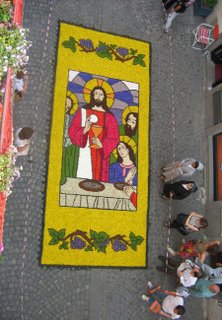Fath Seeking Understanding for June 18, 2006 -- Corpus Christi
Bolsena is the site of what is known as a “Eucharistic Miracle,” in which the Sacred Host visibly transforms into flesh and blood. While celebrating Mass in 1263 at the Church of St. Christina in Bolsena, Peter of Prague was uncertain as to the truth of the Eucharist. Immediately after the words of consecration, however, the Sacred Host began to bleed. As the drops of blood fell onto the corporal, the astonished priest stopped the Mass, and was taken to nearby Orvieto, where Pope Urban IV was staying. Immediately ordering an investigation, the Pope ordered the Host and corporal (with the blood stains) to be brought to Orvieto in procession, where they were enshrined in the Cathedral.
St. Thomas Aquinas was asked by the Pope to compose a hymn in honor of the Miracle, and the following year, the feast of Corpus Christi was instituted in the universal calendar. St. Thomas’ hymn, the Lauda Sion, is a remarkable theological summary of the Church’s faith in the Eucharist while being an equally beautiful and artistic composition filled with love for our Lord. Today, the Lauda Sion remains in the Liturgy as an optional sequence before the Gospel on today’s feast.
 Each city celebrates this feast with a Eucharistic procession, in which the relic of the Eucharistic miracle is carried throughout the town; at the end of the procession, the Blessed Sacrament is carried in an ornate monstrance. Benediction is celebrated at small altars set up throughout the procession-route. Bolsena is particularly unique, however, because the townspeople adorn the entire route with flower-mosaics. These mosaics are created with fresh flower petals and leaves, on patches of dirt, to honor the Blessed Sacrament. Only the priest or bishop carrying the monstrance with the Eucharist steps on the beautiful flowers; everyone else in the procession carefully avoids them.
Each city celebrates this feast with a Eucharistic procession, in which the relic of the Eucharistic miracle is carried throughout the town; at the end of the procession, the Blessed Sacrament is carried in an ornate monstrance. Benediction is celebrated at small altars set up throughout the procession-route. Bolsena is particularly unique, however, because the townspeople adorn the entire route with flower-mosaics. These mosaics are created with fresh flower petals and leaves, on patches of dirt, to honor the Blessed Sacrament. Only the priest or bishop carrying the monstrance with the Eucharist steps on the beautiful flowers; everyone else in the procession carefully avoids them.
Even though participating in both processions was incredibly exhausting, the experience was unforgettable and deeply moving. Beyond giving honor and glory to our Lord, physically present in the Eucharist, these processions recall the importance of cultural expressions of our Faith. There can be no doubt, after witnessing such care and devotion, as to our Faith in the Eucharist. Processions, celebrations, religious plays, and religious music all strengthen our practice of the Faith and provide opportunities for evangelism.
The Feast of the Body and Blood of Christ also gives us an opportunity to reflect on the importance and the meaning of the Eucharist in our own lives. As the Second Vatican Council teaches, the Eucharist is “the source and summit of the Christian life” (Lumen Gentium, 11; cf. CCC, 1324). The Eucharist is not only the goal of our life, it is the means by which we reach that goal. It is the pinnacle of our worship, while being the fulfillment of God’s sanctification of His people. In the Eucharist, we not only encounter God in an absolutely unique way, we are united to Him in anticipation of eternal life.
Although Christ is present in His word, in the prayer of the Church, in the poor and downtrodden, He is present “most especially in the Eucharistic species” (Vatican II, Sacrosanctum Concilium, 7). The Eucharist is a presence unlike all others, because it is the substantial presence of God among us, in His flesh and blood. Finally, this Eucharistic Presence of Christ “begins at the moment of consecration and endures as long as the Eucharistic species subsist. Christ is present whole and entire in each of the species and whole and entire in each of their parts” (CCC 1377).
We sing the praises of our Lord in the Eucharist with St. Thomas Aquinas, in the Adoro te devote:
Godhead here in hiding, whom I do adore,Masked by these bare shadows, shape and nothing more,
See, Lord, at Thy service low lies here a heart
Lost, all lost in wonder at the God thou art.
Seeing, touching, tasting are in thee deceived:
How says trusty hearing? that shall be believed;
What God’s Son has told me, take for truth I do;
Truth Himself speaks truly or there’s nothing true.

<< Home